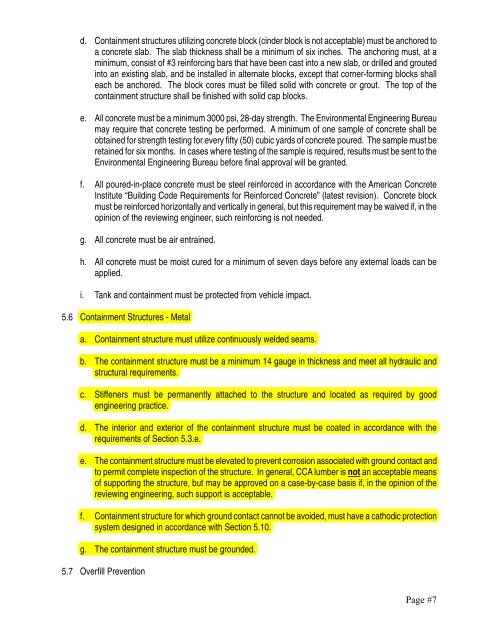Aboveground Tanks (Outdoors) - Guidelines - Brookhaven National ...
Aboveground Tanks (Outdoors) - Guidelines - Brookhaven National ...
Aboveground Tanks (Outdoors) - Guidelines - Brookhaven National ...
Create successful ePaper yourself
Turn your PDF publications into a flip-book with our unique Google optimized e-Paper software.
d. Containment structures utilizing concrete block (cinder block is not acceptable) must be anchored to<br />
a concrete slab. The slab thickness shall be a minimum of six inches. The anchoring must, at a<br />
minimum, consist of #3 reinforcing bars that have been cast into a new slab, or drilled and grouted<br />
into an existing slab, and be installed in alternate blocks, except that corner-forming blocks shall<br />
each be anchored. The block cores must be filled solid with concrete or grout. The top of the<br />
containment structure shall be finished with solid cap blocks.<br />
e. All concrete must be a minimum 3000 psi, 28-day strength. The Environmental Engineering Bureau<br />
may require that concrete testing be performed. A minimum of one sample of concrete shall be<br />
obtained for strength testing for every fifty (50) cubic yards of concrete poured. The sample must be<br />
retained for six months. In cases where testing of the sample is required, results must be sent to the<br />
Environmental Engineering Bureau before final approval will be granted.<br />
f. All poured-in-place concrete must be steel reinforced in accordance with the American Concrete<br />
Institute “Building Code Requirements for Reinforced Concrete” (latest revision). Concrete block<br />
must be reinforced horizontally and vertically in general, but this requirement may be waived if, in the<br />
opinion of the reviewing engineer, such reinforcing is not needed.<br />
g. All concrete must be air entrained.<br />
h. All concrete must be moist cured for a minimum of seven days before any external loads can be<br />
applied.<br />
i. Tank and containment must be protected from vehicle impact.<br />
5.6 Containment Structures - Metal<br />
a. Containment structure must utilize continuously welded seams.<br />
b. The containment structure must be a minimum 14 gauge in thickness and meet all hydraulic and<br />
structural requirements.<br />
c. Stiffeners must be permanently attached to the structure and located as required by good<br />
engineering practice.<br />
d. The interior and exterior of the containment structure must be coated in accordance with the<br />
requirements of Section 5.3.e.<br />
e. The containment structure must be elevated to prevent corrosion associated with ground contact and<br />
to permit complete inspection of the structure. In general, CCA lumber is not an acceptable means<br />
of supporting the structure, but may be approved on a case-by-case basis if, in the opinion of the<br />
reviewing engineering, such support is acceptable.<br />
f. Containment structure for which ground contact cannot be avoided, must have a cathodic protection<br />
system designed in accordance with Section 5.10.<br />
g. The containment structure must be grounded.<br />
5.7 Overfill Prevention<br />
Page #7
















